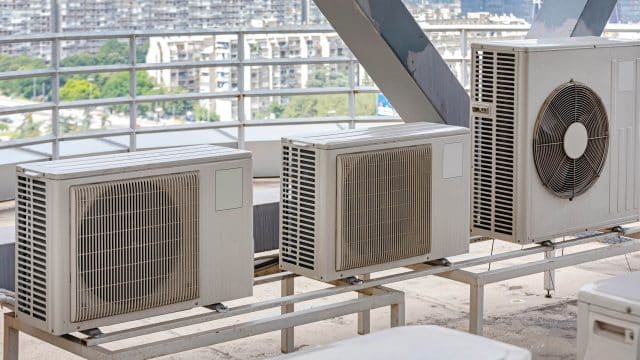
Keeping the ESG Score for Investors
Environmental regulations, societal expectations and political pressures are arguably impacting commercial real estate like never before. The Paris Accord international climate treaty and a 2019 New York law that regulates the energy efficiency of buildings are just two examples of how environmental, social and governance (ESG) considerations are increasingly influencing the real estate market. Wall Street has begun to embrace ESG investing, and a subculture of organizations have developed scoring systems and online platforms to report, track and measure ESG results.
In this landscape, it’s no wonder companies are evaluating their properties’ environmental impacts and looking to mitigate risks. “It’s a cause for concern because the construction industry has a high environmental impact, particularly with cement and steel manufacturing,” said Ellen Wald, an energy consultant and policy expert. “ESG also plays into U.S. real estate because of fights over natural gas intake for new construction, renewable energy requirements and energy efficiency demands in places like California, Massachusetts and New York.” (Wald is scheduled to speak at the Bergstrom Real Estate Center’s Trends and Strategies Conference in Orlando Feb. 23-24.)
The term “ESG” was coined in 2004 in a U. N. Global Compact report entitled “Who Cares Wins: Connecting Financial Markets to a Changing World.” The report, created with the participation of major financial institutions (including Goldman Sachs, Credit Suisse and UBS), emphasized that corporations should measure their worth not just by shareholder value, but other effects on stakeholders, such as environmental impacts, social well-being and corporate governance.

There’s a bevy of critics who assert that ESG amounts to the “greenwashing” of corporate reputations, as companies’ market “green” initiatives that sound good but are impossible to measure. Even the Securities and Exchange Commission is investigating: It created a task force last year to examine misleading ESG claims by banks and investment fund managers. Despite such scrutiny, ESG investing seems here to stay. In 2021, investors plowed a record $70 billion into “sustainable funds,” up 35% from the prior year, according to Morningstar, an investment research firm. Moreover, 3,800 companies have joined as signatories to support the U.N.-supported Principles for Responsible Investment, representing $121 trillion of assets, up from $6.5 trillion in 2006.
But, when it comes to deciding where to put their money, few investors are solely motivated by a company’s ESG score. Shareholders also demand competitive returns on their investments. This raises important questions for investors and corporate managers:
- Does having an ESG rating influence investment returns?
- Is the rating level important to returns?
- Does the effect of ratings vary by specialization?
Methodology in Analyzing ESG Scores

We analyzed the returns of real estate investment trusts (REITs) to explore the relationship between investment performance and ESG ratings with particular attention to E ratings given this component’s high relevance to the real estate industry. Undoubtedly, E is the costliest to implement, most prominent and debated facet of ESG — particularly in the real estate sector. Consider the example of New York’s Local Law 97, which requires most buildings over 25,000 square feet to meet new energy efficiency and greenhouse gas emissions limits by 2024, with stricter limits coming into effect in 2030; building owners face penalties if they miss targets.
We found eight sources that track the ESG performance of REITs, including the Global Real Estate Sustainability Benchmark (GRESB), the National Association of Real Estate Investment Trusts (NAREIT) and the European Public Real Estate Association. We decided to rely on Bloomberg, which tracks ESG metrics of REITs based on the ratings from these and other organizations. Bloomberg’s ratings range 0 to 10, with 10 the best, and they’re broken out for each of the three categories: environmental, social and governance. The environmental component is made up of scores for the energy efficiency of buildings, use of renewable energy, water management, climate exposure, sustainable product and emission management. The social score consists of labor practices, human capital, product liability, social opportunities and stakeholder opposition. The governance score includes board independence, diversity and shareholders’ rights.
Top Five REITs Ranked by E Ratings
| REIT | E Rating | 2020 Returns | 2020 Market CAP (in millions) |
|---|---|---|---|
| Hudson Pacific Pptys Inc | 5.7 | -34% | $3,637 |
| Sl Green Realty Corp | 5.5 | -29% | $4,201 |
| Pebblebrook Hotel Trust | 5.4 | -30% | $2,457 |
| Brixmor Property Group Inc | 5.4 | -20% | $4,907 |
| Sunstone Hotel Investors Inc | 5.1 | -18% | $2,443 |
Bottom Five REITs Ranked by E Ratings
| REIT | E Rating | 2020 Returns | 2020 Market CAP (in millions) |
|---|---|---|---|
| Caretrust Reit Inc | 0 | 14% | $2,112 |
| Global Medical Reit | 0 | 6% | $646 |
| Nexpoint Residential Tr Inc | 0 | -3% | $1,058 |
| Lamar Advertising Co -Cl A | 0 | -3% | $8,398 |
| Sabra Health Care Reit Inc | 0 | -12% | $3,657 |
We analyzed the performance of 165 U.S.-based REITs from 2017 to 2020 and found that 94 of them received ESG ratings. We then examined the annual financial performance of all the REITs using data from S&P Global Market Intelligence.
Our initial method of analysis was to simply segment the REITs into various categories and compare the returns in these groupings. We extracted the subset of REITs with ESG ratings from the universe and divided the rated REITs into above- and below-average rated. In another comparison, we divided REITs into eight asset classes: industrial, office, residential, retail, hotel, heath care, specialized and diversified. We used statistical measures such as median, standard deviation and mean to analyze these categories. We noted contradictory results from this series of categorical comparisons. Separately, we applied two linear regression models to the universe of REITs. We structured one model to determine which REITs are most likely to receive a rating and the other model to identify each factor’s impact on returns. These models helped us identify the results that are statistically significant and allowed us to isolate the specific impact of each factor (rating).
Range of E, S and G scores of rated REITs in 2020
| Rating Category | Minimum | Average (mean) | Maximum |
|---|---|---|---|
| Environmental | 0 | 2.3 | 5.7 |
| Social | 0 | 4.5 | 9.2 |
| Governance | 3.5 | 6.9 | 8.6 |
Question 1: Does having an ESG rating influence REIT returns?
Answer: Yes (at first blush)
We examined REIT returns for the subset of firms with an ESG rating and returns for the universe of REITs. Our findings show that the subset of ESG-rated REITs outperformed the entire set of REITs in three of the four years studied (Figure 1). So, if an investor were to simply reduce their options to only invest in ESG-ranked REITs, that investor would have received a higher return during our study period. This result is not exactly stop-the-press news. It’s in line with numerous reports — from Nasdaq and New York University Stern School of Business to Reuters and McKinsey & Co. — that suggest that companies focused on ESG generate higher overall returns.
Figure 1 – Sources: S&P Capital IQ, Bloomberg, UF Bergstrom Real Estate Center
The comparison results are rather strong and consistent for the short period examined. It seems clear that firms that reported ratings produced higher returns than firms that did not report. However, we must be careful to avoid the trap of declaring a causal relationship from this result. ESG rating and returns seem to be related but does one cause the other? For this answer, we investigated further.
Question 2: Is the rating level important to returns?
Answer: Yes — but perhaps not the way we expect
We analyzed the difference in annual returns between the top 50% of ESG-ranked REITs and the bottom 50% of all ESG-ranked REITs. For all the rated firms, the average rating was calculated for each measure (E, S and G). Firms with an above average rating in each category were assigned to the top 50% and those with below average ratings assigned to the bottom 50%.
The results show higher governance scores correlated with a higher return, but high environmental and social scores do not (Figure 2). A spread above 0 indicates a higher ESG rating leads to higher annual returns. A spread below 0 indicates a lower ESG ranking leads to higher annual returns. Our results were consistent in all years from 2017 to 2020. This means that REITs with high governance scores, low environmental and low social scores generally produce the best annual returns. Keeping focus on the environmental category, we found that on average REITs with low environmental ratings have higher annual returns.
Figure 2 – Sources: S&P Capital IQ, Bloomberg, UF Bergstrom Real Estate Center
Though not a subject of our limited study, one could hypothesize the low performance by REITs that are highly ranked for the environmental criteria indicates there may be a cost to obtaining a high E score, which could outweigh the benefit obtained by being ESG ranked.
Question 3: Does the effect of ratings vary by specialization?
Answer: Yes
We selected three sectors for which we expect an environmental rating to have a significant impact — office, residential and specialized — to see if a low environmental rating produces a higher return.
Residential and specialized REITs both showed that a low environmental score outperformed a high environmental score in three out of four years studied. In only one year did a higher E ranking lead to higher returns in residential and specialized REITs. For office REITs, firms with low environmental ratings outperformed those with higher ratings in half of the years, though the magnitude of the results gave an edge overall to lower E scores producing higher returns. (Figure 3)
Figure 3 – Sources: S&P Capital IQ, Bloomberg, UF Bergstrom Real Estate Center
It is also worth noting that in 2019 and 2020, for all three asset classes, the highest 50% of all environmentally ranked REITs underperformed relative to the entire REIT data set. The negative results for a high E score are particularly interesting because this contradicts the finding in Figure 1 that ESG-rated REITs outperform all REITs. Although, this reinforces our results that ESG-rated REITs with low environmental scores produce the best annual returns. Overall, the simple comparison method has led to conflicting conclusions. Firms reporting ratings for ESG produced higher returns but firms with lower ratings outperformed firms with higher ratings. We also see that performance is not consistent across all REITs, so competing influences should be measured.
Resolving the Conflict
We have considered that our basic analysis could be misleading because it ignores several items that may affect annual returns. So, we ran a least-squared regression model to isolate the return effects of various factors. The first objective was to determine the characteristics of REITs that report ESG ratings. We created a dummy system (0 or 1) to identify REITs with ESG ratings versus those without ratings. The ESG-ranking dummy data served as dependent variable and the independent variables were the year of return, market capitalization, REIT asset type and geometric annual return. This setup allowed us to determine which independent market variables have significant correlation to REITs reporting an ESG ranking.
Our regression model showed that REITs with a higher market capitalization are more likely to hold an ESG ranking than smaller REITs (Figure 4). This makes sense if one considers that larger REITs tend to be more established and have more resources to track and submit the numerous metrics required to obtain an ESG score from Bloomberg and other ESG frameworks. Additionally, REITs that are diversified across asset type are less likely to hold an ESG rating.
Factors that affect the likelihood that a REIT has an ESG rating
| Statistically Significant Results | Coefficient | P-Value |
|---|---|---|
| Diversified REITs | -23.08% | <.0001 |
| Health care REITs | 10.74% | 0.0236 |
| Office REITs | 12.36% | 0.0017 |
| Market capitalization | 17.21% | <.0001 |
Figure 4 – Sources: S&P Capital IQ, Bloomberg, UF Bergstrom Real Estate Center
The results also show that office and health care REITs are more likely to have an ESG rating. The positive relationship between the office sector and ESG ratings is not a surprise when you consider that the Leadership in Energy and Environmental Design (LEED) — the rating system used by the U.S. Green Building Council to measure a building’s sustainability and resource-efficiency — originated in the office sector. We did not get significant results for the residential, industrial, specialized, hotel and retail REITs.
With the knowledge that ESG ratings are more closely associated with larger office and health care REITs, we constructed a regression model to measure the effects of various characteristics on returns. The model includes property type, market capitalization, year and each rating. Allowing the model to account for firm size and property characteristics, we turned our focus to the coefficients on the ratings variables.
Of the ESG ratings, only the E score significantly affects REIT annual returns (Figure 5). If a REIT works to increase its environmental rating, the higher ranking will come at a cost to bottom-line performance. A parameter estimate of -2.67%, with a standard deviation of 1% indicates that the impact is statistically significant and implies that a one-point boost in a REIT’s E score translates to a 2.67 percentage point decrease in its annual return. For example, a REIT that increases its E rating from 2 to 3 will effectively pay 267 basis points of annual return for the higher ranking.
Percentage change in average annual return broken out by whether a REIT has ESG ratings
| Selected results | Coefficient | P-Value |
|---|---|---|
| Environmental Rating* | -2.67% | 0.0078 |
| Social Rating | -0.12% | 0.8437 |
| Governance Rating | 1.21% | 0.2922 |
| Market Capitalization* | 2.57% | 0.0003 |
*One point increase in an E rating results in a 2.67 percentage point decrease in annual return 2017-2020. One percent increase in market capitalization leads to a 2.57 percentage point increase in annual returns for the same period.
Figure 5 – Sources: S&P Capital IQ, Bloomberg, UF Bergstrom Real Estate Center
Neither S nor G scores produced statistically significant effects on annual returns. Thus, we determined that separately each of these measures have no impact on REIT returns. The regression results also confirmed that REITs with larger market capitalizations performed better than smaller REITs. This is significant because, as noted above, we also know that larger REITs are more likely to hold an ESG rating.
Key Takeaways
It is easy to see why there are presentations suggesting that firms improving their ESG ratings will produce higher returns. This conclusion appeared to be confirmed in our initial comparison analysis. However, additional comparisons and more formal modeling revealed that only one of the three ESG ratings significantly impacts returns, and the impact was negative. On the 10-point Bloomberg scale, a one-point change represents a 10% adjustment. We can loosely conclude that improving an environment rating by 10% will cost investors approximately 267 basis points of return.
This conclusion should not deter investors and REIT managers from pursuing environmentally friendly strategies. It only suggests that making these changes may come at a cost to investors. This seems fitting. After all, to achieve the publicly desired outcome of a healthier planet, companies must spend more on “green” technologies and practices. This requires us to make a payment rather than receive a payoff — at least in the short term. Despite this, we can all hope that investors will choose to pay the price for an improved environment, and that refinements are made to the ESG system so we can differentiate between those practices that are just green fluff and ones that truly benefit the planet.

